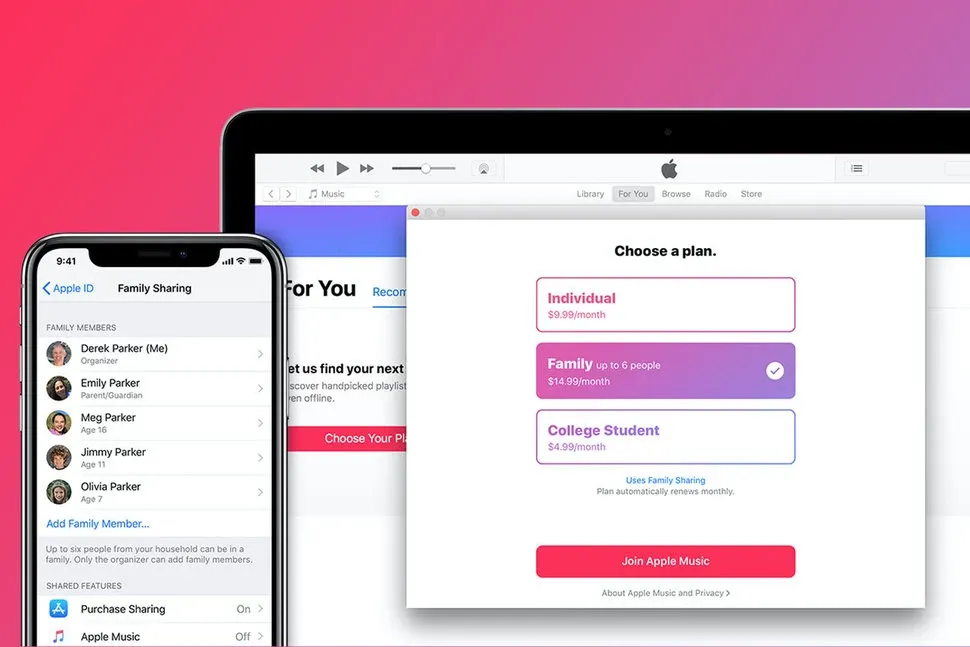Apple Music
At least 50% off from FlexSub
Subscribe Now
The new Apple Music streaming service has been available for some time now, giving users sufficient opportunity to not just test but also live with its numerous features. (The first three months are free.) I'm already a great admirer of the equivalent Spotify premium service, and I despise, despise, despise iTunes, Apple Music's often-confusing desktop client. So I was ready to resist Apple's version of the all-you-can-listen music membership.
But, with some doubts, I'm thinking about switching after the free trial period is done. And if you haven't tried a streaming service yet, this is one you should.
Apple Music, I believe, will pique the curiosity of slightly older customers like myself (as in, over 40). Not only are we accustomed to paying for music, but Apple Music is also built to work with our existing digital libraries. Here's everything you need to know about Apple Music, including how much it (actually) costs and how it compares to competing streaming music services.
What is the best way to acquire Apple Music?
It's included in the most recent versions of iTunes and the Music app on your iPhone or iPad. To see it, you'll need to update your phone or tablet to the current version of iTunes or the iOS operating system. Apple Music isn't yet accessible on Android phones, but it will be later this year.
What's the difference between Apple Songs and buying music from the iTunes Store?
Apple is credited with inventing the concept of buying music online, but until recently, its main focus was on selling song-by-song downloads for 99 cents to $1.29 per on iTunes. You can listen to any of the songs in Apple Music's repertoire for $10 per month. The songs or albums can be streamed or downloaded and played directly from your computer, iPhone, or iPad via an Internet connection. However, you are renting rather than purchasing. If you let your Apple Music subscription lapse, your songs won't play on your phone or computer. (However, music purchased on iTunes remains yours.)
With a few noteworthy exclusions, such as the Beatles, Apple claims to have a collection of 30 million songs on Apple Music, which is similar to what you can buy directly on iTunes. More on those exceptions later—there is a method to work around them (kind of), and it could be Apple's major competitive weapon.
How much does it cost?
A monthly subscription for an individual is $10. This isn't groundbreaking: equivalent plans on Spotify and most other streaming services, such as Rdio, Google Play Music All Access, Rhapsody, and Tidal, cost the same. A $15 monthly Apple Music family subscription allows up to six family members to utilise the service at the same time. That's a somewhat better price for families with more than two users than most other providers' current family plans, which charge $5 for each additional user. Spotify, for example, is currently $15 for two people and $20 for three. In any case, Apple Music is only $15.
Any of these selections will seem like a steal to anyone who remembers buying CDs for $15 each. However, it does not cover the entire amount. You'll eat up a lot of your wireless data plan if you start streaming music and listening in your car, or when running, strolling, or otherwise out of wi-fi range. (My wife, for example, consumes less than 1 gigabyte of data each month, whereas I frequently use more than 2 gigabytes.) The difference is nearly completely due to my use of Spotify and, more recently, Apple Music.) If you're not careful, starting to stream music on any provider may easily add $15 to $30 per month to your account, depending on your plan and how much you currently use. And I'm not normally like that.
You can reduce this cost by downloading playlists or prefered songs on your phone while connected to the internet. (On Apple Music, select a song, album, or playlist, then select "Make accessible offline" from the "..." menu.) The roles of the other services are similar.)
Isn't there a plethora of free music streaming services I could utilise instead?
Yes, but if you refuse to pay, you will be limited. Spotify and Rdio both offer free account choices that allow you to choose any music you want—but only if you listen on a computer. On a phone or tablet, you have less control over the songs you listen to; for example, on Spotify's free version, you can choose an album to listen to but only on shuffle. You must pay the $10 monthly fee to gain complete management.
Free ad-supported Internet "radio" services like Pandora and Songza are also available, but you can't pick and choose whatever music you wish to hear. Instead, you'll be assigned to a station or playlist based on your preferences, favourite artists, or current mood.
There are numerous free radio channels on Apple Music, including the live Beats 1 broadcast (complete with old fashioned DJs cueing up it high-energy pop music). Except for the ease of having them incorporated right into the iPhone's Music app, they're OK, but nothing particularly innovative.
What sets Apple Music apart from Spotify, Rdio, Google Play Music All Access, Rhapsody, and Tidal premium subscriptions?
To be honest, most of the differences between services aren't significant once you've paid for a membership, at least not for iPhone users. All of the other services have attractive apps that operate on iPhones and iPads, with the added benefit of being compatible with Android. Every $10-a-month Apple Music plan includes a nearly equal selection, albeit playlists and music recommendations are organised differently. Apple Music, for example, places a strong emphasis on encouraging you to listen to short "curated" playlists created by Apple's own editors or by major music publications and websites. It's easier to come across odd playlists put up by other Spotify users on Spotify, which is a feature I personally love.
I really like Spotify's runner-specific playlists and capabilities, which include a feature that selects music that matches your pace. Apple's running playlists didn't appeal to me as much. Tidal's added selling point for audiophiles is a more expensive, $20-per-month option that allows you to listen to higher-quality streams.
All of this, though, is a question of personal preference.
Almost any piece of music you can think of is available on a variety of platforms. Because it's about the deals each corporation can make with whoever controls the music rights, the variances are annoyingly unpredictable. There are significant catalogue gaps in every service. 1989 is only available on Apple Music and no other streaming service. Prince's music is available on Tidal but not on Spotify or Apple Music. Neil Young's music has been pulled from all on-demand providers. The Beatles have yet to be secured for on-demand streaming.
Is there any incentive for me to switch if I already enjoy Spotify, Rdio, or Tidal? Aside from Taylor Swift, anyone else?
Well, here's one thing that has me at least thinking about it: While you won't be able to stream the Beatles or Prince on Apple Music, if you already own their music (or purchase it on iTunes), Apple makes it simple to mix it in with subscription music you stream, all within the same Music app.
To be clear, Apple isn't the only company that lets you mix your own music with what it streams. On your computer, Spotify makes this quite simple, and you can even download tracks from your computer to your phone and listen to them within the Spotify app. You may upload your own music to Google Play Music All Access and listen to it on any device using the Play Music app. (With this feature, Google was much ahead of Apple Music.) Apple Music's method, on the other hand, is far more simple and evident if you currently use iTunes as your music hub.
To give you an illustration of what I'm talking about, consider the following: I went into the Music app before a recent run and was able to quickly make a playlist mix that included two Beatles songs I already owned, a Prince song, and even an unreleased recording by my father-in-jazz law's group, as well as a half-dozen tracks I don't own but streamed via Apple Music.
This would irritate me if I were an Apple competitor. Because Apple controls the default Music app on its phones, Apple Music has an advantage here. However, for many people, it will be a desirable feature.
What are some of Apple Music's flaws?
Apple Music is not yet accessible on Android phones or tablets, as previously stated. Furthermore, if you want to listen on a computer, you must use iTunes, although other services allow you to listen through any online browser. This can be useful if you aren't allowed to instal the latest version of iTunes on a work computer, for example. (Of course, you could always use Rdio or Spotfiy for free.)
You could write a dissertation about how Apple Music is meant to interact with Apple's iCloud, iPhone syncing, and the separate, "complementary" iTunes Match online music backup service—still it's a huge, overly complicated piece of software. Some users have complained bitterly that signing up for Apple Music and enabling its iCloud Music Library affected their iTunes music listings significantly problematic, causing album tracks to be mixed up or album artwork to be messed up. Apple has already responded with a new iTunes update and instructions for repairing a jumbled collection, but if you care a lot about how you organise your existing music on iTunes, you might want to wait until most of these issues are resolved. (I didn't have any issues, but I had already backed up my music on iTunes Match, which may have made things easier.)
The fact that the other services save you from having to touch iTunes and don't tamper with your digital collection is actually a significant selling factor for a lot of users.
So, in comparison to other services, Apple Music isn't a clear victor. You have a lot of options, and if you're used to Spotify, Rdio, or Google Play and have a lot of playlists there, you might not be in a hurry to switch.
Apple Music
At least 50% off from FlexSub
Better, flexible and cheaper subscriptions for a wide range of services in just a click of a button.
Get started now

